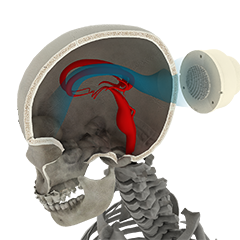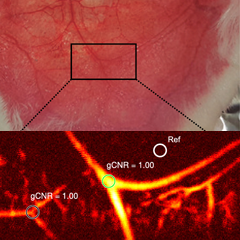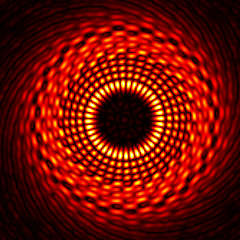Active research lines
Therapeutic ultrasound and acoustic holograms

Optical holograms can modulate light wavefronts to generate visible images. In the same way, acoustic images can also be synthesized by holograms, shaping the areas where mechanical waves present a high amplitude, and areas where the media is at rest. Acoustic holograms have found recent application in biomedical applications, for example, for the non-invasive treatment of neurological disorders. When targeting acoustic beams into the brain, accurate focusing is mainly limited due to the strong phase aberrations produced by the refraction and attenuation of the skull. Acoustic holographic lenses can overcome these limitations by synthetizing aberration-free ultrasonic fields of complex spatial distribution inside the skull. Using low-cost 3D-printed lenses, ultrasonic beams can be focused not only on a single point, but overlapping at one or various target structures simultaneously. We are using holograms for blood-brain barrier opening or neuromodulation, and also for the generation of thermal holographic patterns for hyperthermia.
Lines
Elastographic and molecular ultrasound imaging

Ultrasound has important biomedical applications in both, therapy and imaging. We develop several hybrid ultrasound imaging techniques for biomedical applications combining ultrasound with additional physical mechanisms to go a step beyond standard US imaging techniques. These include photoacoustic imaging, combining laser with ultrasound; and magneto-motive ultrasound, combining magnetic fields, magnetic nanoparticles and ultrasound, to obtain images with molecular contrast. In addition, we are developing ultrasound elastography modalities, combining external forces, torques, and shear deformations with ultrafast ultrasound imaging to map the stiffness of tissues. Finally, we also develop quantitative ultrasonic imaging technology to be applied to the field of odontology, quantifying parameters such as the demineralization or to monitor dental implants.
Lines
Acoustic vortices and singular beams

An acoustic vortex beam is a type of sound wave that carries orbital angular momentum (OAM), characterized by a spiral phase front and a central pressure null or "vortex core". Unlike conventional acoustic beams, its wavefront twists around the propagation axis, forming a helical shape. These beams can be used for particle manipulation, acoustic communications, and high-resolution imaging, thanks to their unique ability to exert rotational forces on objects. In addition, I'm studying nondiffracting acoustic beams, that can be generated under specific conditions. I'm interested in the generation of singular beams such as zero-th and higher order Bessel beams and the techniques to generate them. For example, these can be generated by using diffraction gratings in the same manner as Fresnel zone plates, or by using acoustic metamaterials. Focusing is also considered and acoustic vortices can be easily generated by passive devices. Furthermore, nondiffracting nonlinear beams have also been obtained by using sonic crystals under self-collimation regime. Moreover, at hight field amplitudes, beams behave different from the prediction of linearized models. For example, high intensity focused ultrasound fields are characterized in the focal area by the appearance of nonlinear acoustic effects such as harmonic generation and self-(de)focusing.
Lines
Acoustic metamaterials and phononic crystals

Acoustic metamaterials are artificial structures with striking and exotic properties not found in conventional or natural materials. By exploiting the concepts of strong dispersion and slow sound, as well as negative compressibility and negative mass density, it is possible to design these new materials to exhibit interesting properties such as perfect sound absorption, zero sound transmission, sound focusing and specific scattering patterns. Additionally, the dynamics of high-amplitude acoustic waves travelling through periodic structures exhibit unique properties, such as anisotropic dispersion. A wide range of nonlinear phenomena emerge due to the interaction between nonlinearity and wave dispersion. My research focuses on nonlinear localized waves in various media, including cation lattices, layered acoustic media, sonic crystals and macroscopic lattices of oscillators.
Lines
Simulation of acoustic and elastic waves in complex media

I'm designing simulation techniques for acoustic fields in complex media. These computational methods include nonlinear acoustic propagation, arbitrary frequency dependent attenuation and dispersion for modelling biological media, as well as elastic waves in complex solid media. These time domain algorithms include arbitrary boundary conditions and media heterogeneity, and can be applied to biomedical ultrasound applications. On the other hand, I designed computational techniques for describe finite amplitude propagation through lattices and periodic media.
Lines
Industrial applications of ultrasound

Beyond the medical use of ultrasound, I'm developing together with Francisco Camarena's UMIL lab at I3M several industrial applications of ultrasound, mostly under agreement and contracts with private companies. These include industrial applications of ultrasound for food texture and quality characterization, and custom ultrasonic sensors and actuators for specific industrial applications. We are open to design, optimize and fabricate transducers on request for industrial applications.